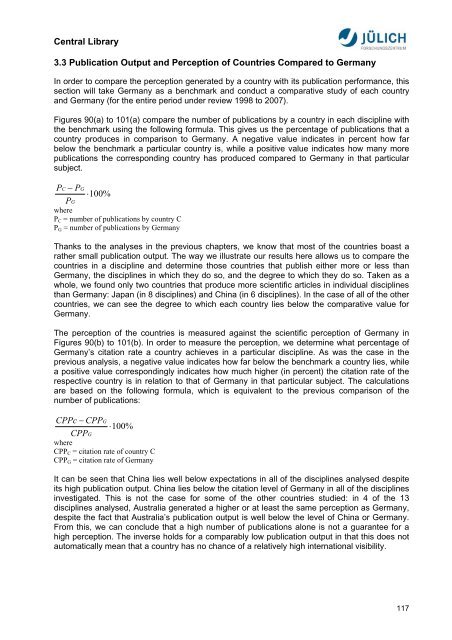Bibliometric Analysis Asia-Pacific Research Area ... - JuSER
Bibliometric Analysis Asia-Pacific Research Area ... - JuSER
Bibliometric Analysis Asia-Pacific Research Area ... - JuSER
- No tags were found...
Create successful ePaper yourself
Turn your PDF publications into a flip-book with our unique Google optimized e-Paper software.
Central Library<br />
3.3 Publication Output and Perception of Countries Compared to Germany<br />
In order to compare the perception generated by a country with its publication performance, this<br />
section will take Germany as a benchmark and conduct a comparative study of each country<br />
and Germany (for the entire period under review 1998 to 2007).<br />
Figures 90(a) to 101(a) compare the number of publications by a country in each discipline with<br />
the benchmark using the following formula. This gives us the percentage of publications that a<br />
country produces in comparison to Germany. A negative value indicates in percent how far<br />
below the benchmark a particular country is, while a positive value indicates how many more<br />
publications the corresponding country has produced compared to Germany in that particular<br />
subject.<br />
PC<br />
− P<br />
PG<br />
G<br />
⋅100%<br />
where<br />
P C = number of publications by country C<br />
P G = number of publications by Germany<br />
Thanks to the analyses in the previous chapters, we know that most of the countries boast a<br />
rather small publication output. The way we illustrate our results here allows us to compare the<br />
countries in a discipline and determine those countries that publish either more or less than<br />
Germany, the disciplines in which they do so, and the degree to which they do so. Taken as a<br />
whole, we found only two countries that produce more scientific articles in individual disciplines<br />
than Germany: Japan (in 8 disciplines) and China (in 6 disciplines). In the case of all of the other<br />
countries, we can see the degree to which each country lies below the comparative value for<br />
Germany.<br />
The perception of the countries is measured against the scientific perception of Germany in<br />
Figures 90(b) to 101(b). In order to measure the perception, we determine what percentage of<br />
Germany’s citation rate a country achieves in a particular discipline. As was the case in the<br />
previous analysis, a negative value indicates how far below the benchmark a country lies, while<br />
a positive value correspondingly indicates how much higher (in percent) the citation rate of the<br />
respective country is in relation to that of Germany in that particular subject. The calculations<br />
are based on the following formula, which is equivalent to the previous comparison of the<br />
number of publications:<br />
CPPc − CPPG<br />
⋅100%<br />
CPPG<br />
where<br />
CPP C = citation rate of country C<br />
CPP G = citation rate of Germany<br />
It can be seen that China lies well below expectations in all of the disciplines analysed despite<br />
its high publication output. China lies below the citation level of Germany in all of the disciplines<br />
investigated. This is not the case for some of the other countries studied: in 4 of the 13<br />
disciplines analysed, Australia generated a higher or at least the same perception as Germany,<br />
despite the fact that Australia’s publication output is well below the level of China or Germany.<br />
From this, we can conclude that a high number of publications alone is not a guarantee for a<br />
high perception. The inverse holds for a comparably low publication output in that this does not<br />
automatically mean that a country has no chance of a relatively high international visibility.<br />
117















